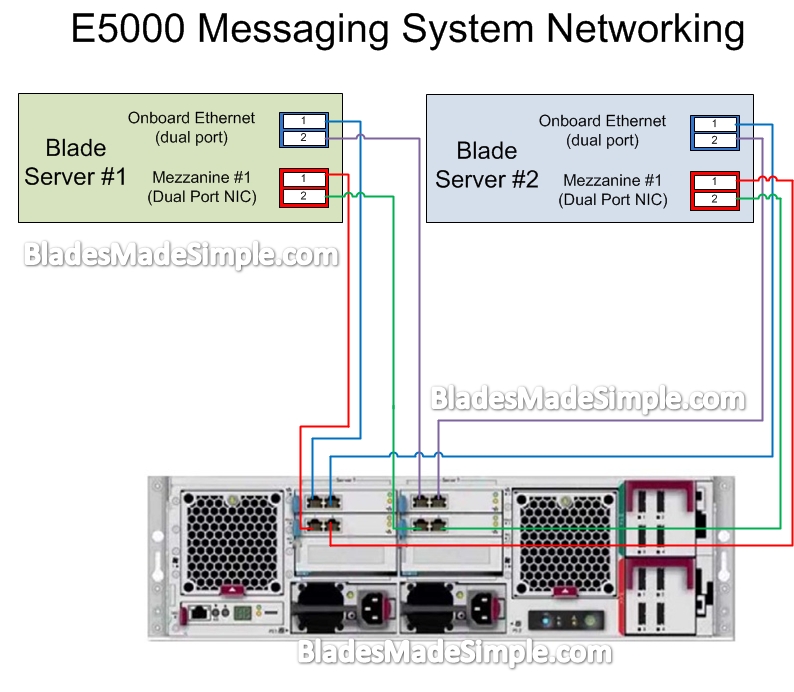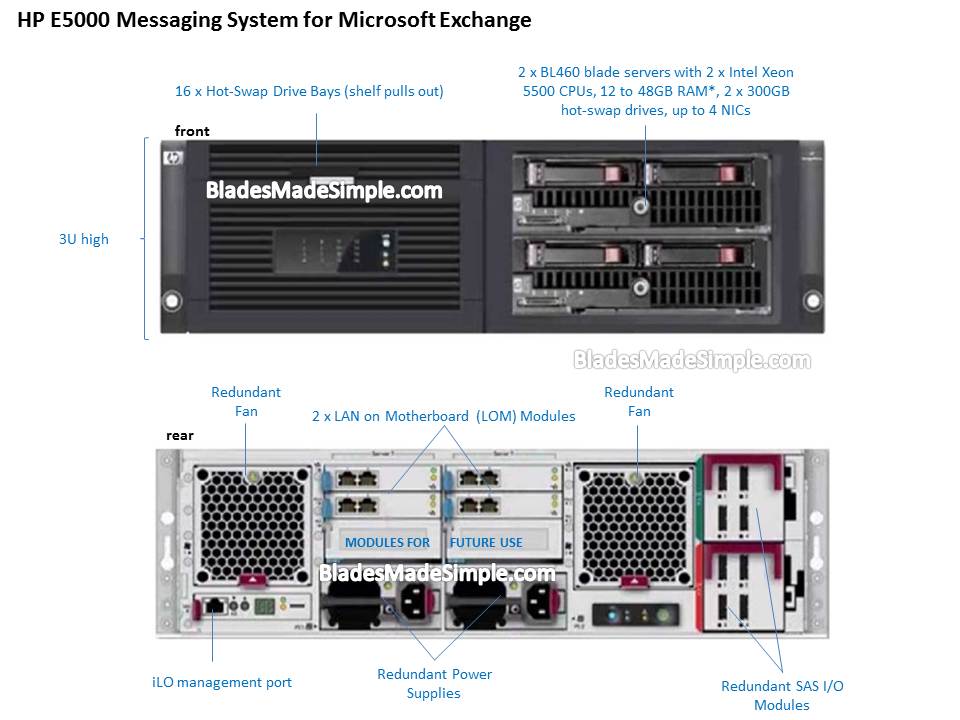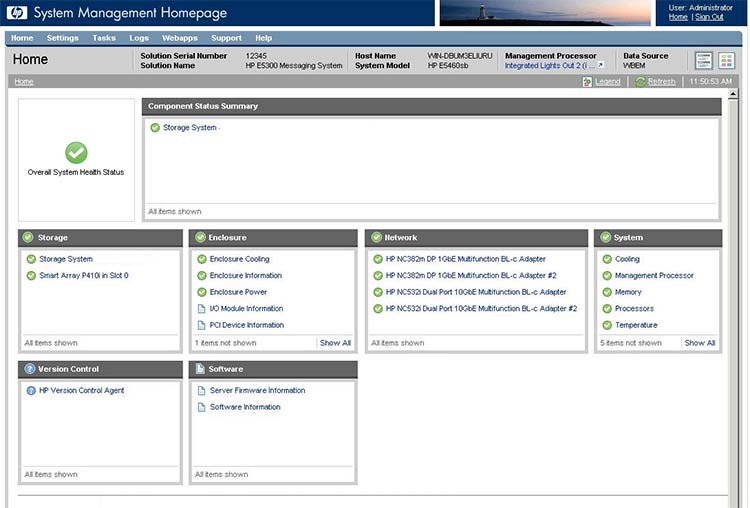Anyone who reads this site frequently will know that I try to predict the future and speculate on what’s to come in the realm of blade server technology. HP recently developed a new offering that opens up the possibilities of how blade servers will be used in the near future.
In early March of this year, from a tight partnership with Microsoft, HP created the HP E5000 Messaging System for Microsoft Exchange Server 2010. This single part number offering gives users nearly everything they need to stand up a Microsoft Exchange 2010 server using best practices from both HP and Microsoft.
The E5000 is a 3U high system that includes 16 hot-swap drive slots combined with a pair of HP BL460 blade servers powered with dual Intel Xeon 5500 CPUs. This is what makes the offering exciting to me. HP has created a new use case for blade servers that don’t require investing into a huge shared infrastructure. HP could have used DL380’s like they did back in the early 2000’s with the HP Proliant DL380 G3 Packaged Cluster, but now that technology has advanced, HP can get the horsepower they need to drive an application like Microsoft Exchange.
The system comes with the Microsoft Windows 2008 R2 Enterprise server software and Microsoft Exchange 2010 Enterprise software pre-installed. With the aid of a wizard driven interface, HP claims that users can stand up the E5000 Messaging System in a matter of minutes, versus days with the traditional manner. The wizard helps walk you through all phases of setting up your system, including creating the Microsoft Exchange Database Availability Groups (DAGs)
The chassis also has an Enclosure Management Unit, or EMU, that provides acccess to the chassis environmentals (via an EMU processor) and it provides connectivity to the 2 blades’ iLO ports. Here’s a glimpse of what the management looks like. If you have HP gear already, it should look familiar:
Models
HP is offering several versions of the E5000 – each capable of being upgraded in the future:
HP E5300 12 TB LFF MDL SAS Messaging System – 500 1.2 GB mailboxes HP Part #: BV839A
HP E5500 16 TB LFF MDL SAS Messaging System – 1000 1.2 GB mailboxes HP Part #: BV895A
HP E5500 32 TB LFF MDL SAS Messaging System – 1000 2.5 GB mailboxes HP Part #: BV840A
HP E5700 40 TB LFF MDL SAS Messaging System – 3000 1.2 GB mailboxes HP Part #: BV896A
HP E5700 80 TB LFF MDL SAS Messaging System – 3000 2.5 GB mailboxes HP Part #:BV841A
One note that you should be aware of – while the E5000 Messaging System comes with the server software required for the solution, the CALs (Client Access Licenses) are not included. You’ll have to buy them separately. If you need help understanding what CALS you need – send me an email and I’ll help you out.
E5000 Networking
 When I saw this solution in person, my first question to the product engineers was how the I/O worked. The E5000 chassis is a lot different from a traditional blade chassis. For the E5000 messaging solution, there are 4 I/O module slots in use. They are called the LAN-on-Motherboard (LOM) modules and are installed in pairs. The I/O is fairly straight forward: the RJ45 port labled “1” on each module maps to the 1st port on the network card and “2” is well, you get the port. The top two modules map to the onboard NICs to the 2 x BL460’s, the 2nd two modules map to the 2 port NIC pre-installed on the E5500/E5700 modules. If you get the E5300 module, you only get 2 NICs, but it can be upgraded. Here’s a diagram that should make it easier to understand:
When I saw this solution in person, my first question to the product engineers was how the I/O worked. The E5000 chassis is a lot different from a traditional blade chassis. For the E5000 messaging solution, there are 4 I/O module slots in use. They are called the LAN-on-Motherboard (LOM) modules and are installed in pairs. The I/O is fairly straight forward: the RJ45 port labled “1” on each module maps to the 1st port on the network card and “2” is well, you get the port. The top two modules map to the onboard NICs to the 2 x BL460’s, the 2nd two modules map to the 2 port NIC pre-installed on the E5500/E5700 modules. If you get the E5300 module, you only get 2 NICs, but it can be upgraded. Here’s a diagram that should make it easier to understand:
 If you are a careful observer, you may ask – what about that 3rd set of bays located above the power supplies. What are they for? Good question. I did not show that the blade servers each have an HP StorageWorks 1210m Controller located in mezzanine slot 2 that provides blade connectivity to the 16 x SAS drives and the external SAS connectivity. Understanding that I/O bays have to map to mezzanine cards, this tells me that the reason that 3rd set of bays is not in use is because there’s nothing to connect to them. The HP engineers wouldn’t confirm or deny this speculation only that those bays aren’t for use “with this configuration”. That opens other questions as to what other “solutions” is HP working on with this design? Perhaps a Microsoft SharePoint offering or a Microsoft SQL offering. I guess only time will tell.
If you are a careful observer, you may ask – what about that 3rd set of bays located above the power supplies. What are they for? Good question. I did not show that the blade servers each have an HP StorageWorks 1210m Controller located in mezzanine slot 2 that provides blade connectivity to the 16 x SAS drives and the external SAS connectivity. Understanding that I/O bays have to map to mezzanine cards, this tells me that the reason that 3rd set of bays is not in use is because there’s nothing to connect to them. The HP engineers wouldn’t confirm or deny this speculation only that those bays aren’t for use “with this configuration”. That opens other questions as to what other “solutions” is HP working on with this design? Perhaps a Microsoft SharePoint offering or a Microsoft SQL offering. I guess only time will tell.
What do you think of this solution? What other software bundles would you like to see HP offer in this type of packaging? Let me know your thoughts in the comments below.
For more images of the E5000 Messaging System, click here.
To learn more about the HP E5000 Messaging System for Exchange 2010, visit HP’s web site.
make a graph
hyperthyroidism symptoms
government shutdown military pay
muscular dystrophy association
groupon nyc


Pingback: Kevin Houston
Pingback: Daniel Bowers
I know a bit late on commenting, but was just pointed to this. We had the E5000 in our lab for the purpose of looking at ease of use and doing some comparisons. Our experience was very good. Regards, Camberley Bates, http://www.evaluatorgroup.com
Pingback: Kevin Houston